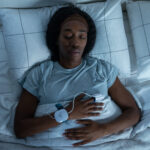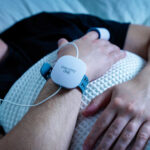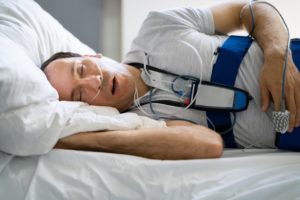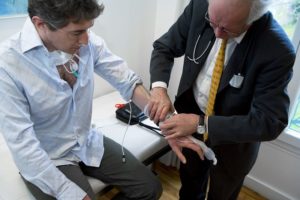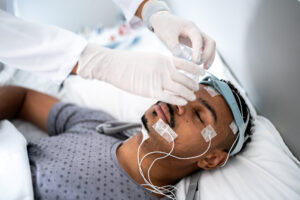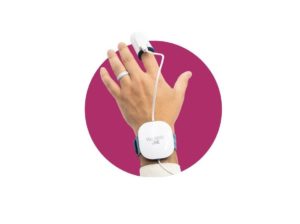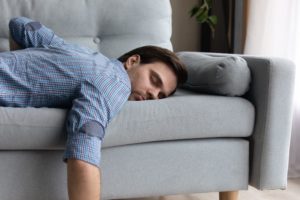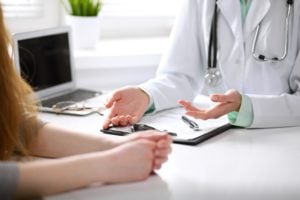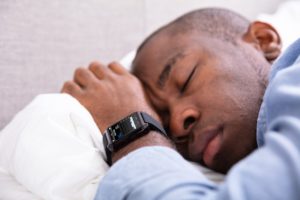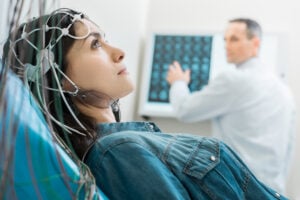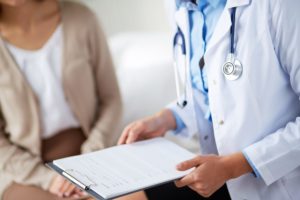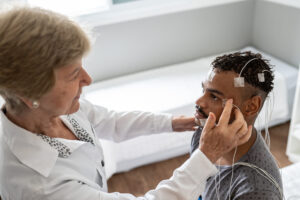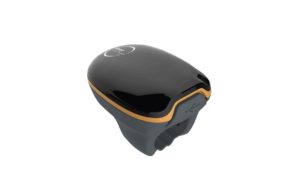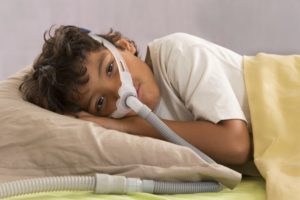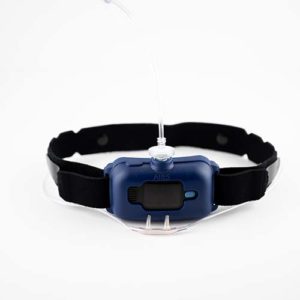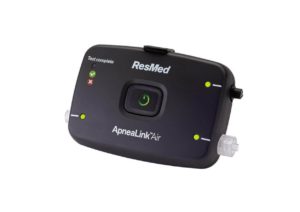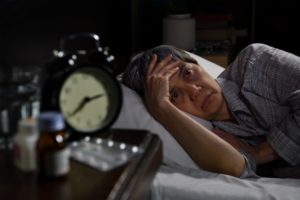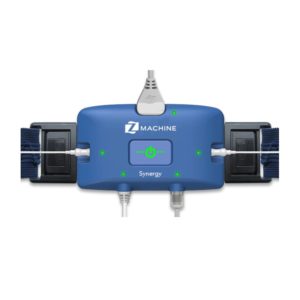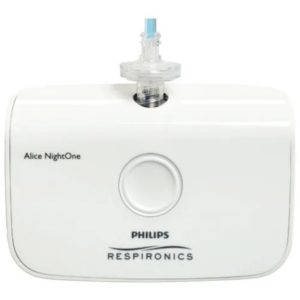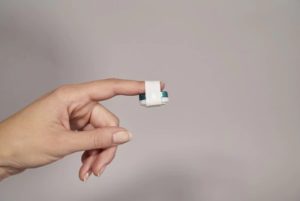When you buy through our links, we may earn a commission. Products or services may be offered by an affiliated entity. Learn more.
At-Home Sleep Apnea Tests
Each year, many cases of obstructive sleep apnea (OSA) go undiagnosed. This disorder causes temporary pauses in breathing during sleep, making diagnosis and treatment essential for overall health and well-being. At-home sleep apnea testing is a convenient alternative to an in-clinic sleep study. But at-home testing is not for everyone and may be most appropriate when sleep apnea is strongly suspected.
What Is an At-Home Sleep Apnea Test?
A home sleep apnea test is a portable breathing monitor you wear overnight. It is designed to help diagnose obstructive sleep apnea at home. As you sleep, the device monitors your breathing and oxygen levels to detect and measure pauses in breathing, which are known as apneas. The test calculates an OSA severity score by calculating the average number of lapses in breathing per hour in bed.
Polysomnography, an overnight sleep study performed in a lab, provides the most accurate diagnosis for obstructive sleep apnea. However, this type of test can be more expensive, and people in certain areas may face long waitlists or lack easy access to a sleep center. At-home sleep apnea tests are designed to make testing more accessible and help ensure people get the treatment they need.
At-home sleep apnea tests may be appropriate for diagnosing OSA in some people, as long as a qualified sleep specialist interprets the results. However, polysomnography is the better option for people who are suspected of having another medical condition or sleep disorder in addition to OSA .
Most at-home sleep apnea tests measure different bodily metrics used to determine whether or not someone has sleep apnea. Common metrics measured during an at-home test include:
- Respiratory activity, breathing patterns, and chest motion
- Heart rate and blood oxygen level
- Actigraphy, or nocturnal movement and motor activity
- Sleep position and position changes
- Snoring events and intensity
It is important to note that most at-home tests do not measure sleep quality. This may be limiting if you are trying to decide whether an at-home test or onsite sleep study is better suited for your specific situation. Comparatively, polysomnography offers a more holistic overview of your sleep quality and sleep patterns in addition to the apnea-related metrics measured by at-home tests.
Best At-Home Sleep Apnea Tests
Our Recommended At-Home Sleep Apnea Test
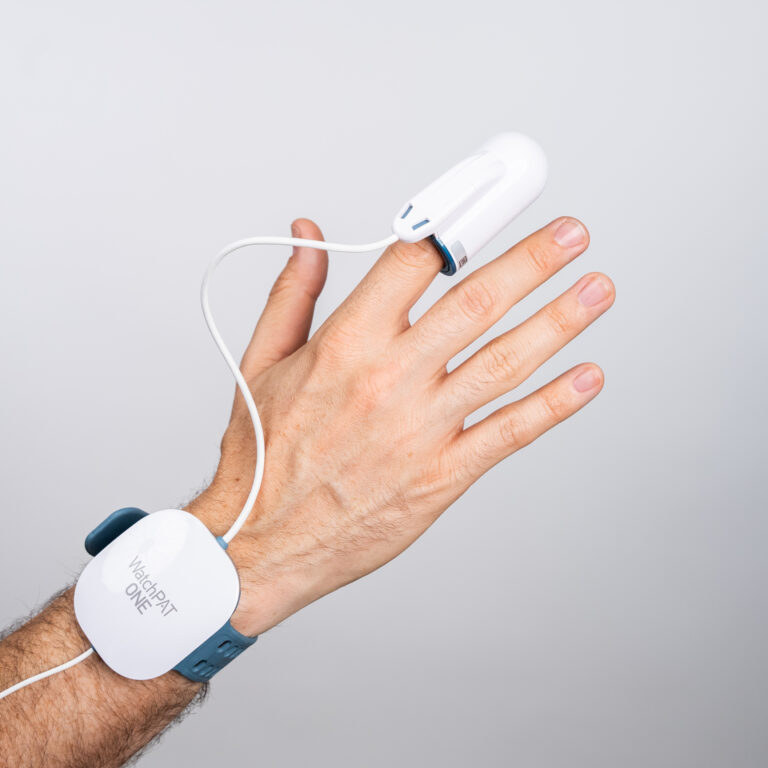
our partner at sleepdoctor.com
Save 46% on your Sleep Test Today
Shop Now“Truly grateful for this home sleep test. Fair pricing and improved my sleep!”
Dawn G. – Verified Tester
While not always effective, at-home sleep apnea tests are a convenient alternative to traditional polysomnography sleep studies that require you to spend the night in a lab away from your bed. At-home tests have evolved over the years, and the wearable Sleep Doctor test is one of the most advanced options sold today. The device consists of a band that fits around your wrist like a watch, a sensor that gently clamps your fingertip, and a thin cord connecting the other two components. No nasal tubes or body straps are required.
The test’s user-friendly design is ideal for anyone who suspects they have obstructive sleep apnea but cannot book a polysomnography appointment in a timely manner or does not want to spend the night in a sleep lab. The Sleep Doctor test is designed for adults who are at least 18 years of age.
The device uses the wrist, finger, and neck as contact points to measure seven different metrics used to diagnose sleep apnea. The peripheral arterial tone (PAT) metric is used to monitor respiratory activity and events, while actigraphy refers to nocturnal movements and motor activity. The Sleep Doctor test also measures heart rate, blood oxygen level, sleep position, snoring, and chest motion.
The process for using the test is simple. After receiving your device in the mail, Sleep Doctor schedules you a virtual appointment with a board-certified physician. During this meeting, the doctor will evaluate your physical health and explain how to use the device. This clears the way for you to use the test. With proper use, you can generate results after just one night of testing. Once you have your results, the same physician will review them and provide a personalized sleep report complete with prescription and treatment recommendations.
The Sleep Doctor test can be used in any setting, so you won’t need to leave your bed to use the device. The device has earned FDA approval, and does not require an appointment with a physician. Your insurance may cover a portion of the up-front costs. Standard shipping is free, and expedited delivery is available for a small surcharge. Unopened orders may be returned within 60 days of purchase.
Why You Should Trust Us
Our team of sleep experts has personally evaluated hundreds of sleep products using our comprehensive testing methodology. Each member of the team brings years of experience and expertise to their testing role. To evaluate at-home sleep apnea tests, members of our team followed the recommended process for each test and logged their results along with notes about their experience.
How At-Home Sleep Apnea Tests Work
The process for at-home sleep apnea testing involves receiving an evaluation and prescription from your doctor, conducting the test at home, and then sending your results to be interpreted by a sleep specialist.
Obtain a Prescription
You should have a prescription from a doctor to obtain the home sleep apnea test. First, you need to schedule an appointment with your primary care physician or a sleep specialist, who will ask you about your symptoms and pre-screen you for obstructive sleep apnea. Then, based on their assessment, they can order the prescription for you and explain how to use the testing kit. You can pick up the test in person or have it delivered to your home.
Take the Test
Depending on the type of sleep test, you may need to use several different sensors.
Sleep tests fall into different categories depending on how accurately they measure different sleep metrics. Home sleep apnea tests are generally classed as type 3 or type 4. Type 3 tests use a greater number of sensors to capture relevant information such as blood oxygen levels, airflow, snoring, body position, or heart rate. There may be variations between tests, as researchers are still developing new testing kits.
Home sleep tests should include measurements of airflow, blood oxygen levels, and breathing effort , at the very least. Common sensors for a type 3 device include an acoustic sensor to calculate airflow, an effort belt that wraps around the chest to track your breathing patterns, and a small clip called an oximeter that you wear on your finger to track your blood oxygen levels.
To ensure a more accurate reading, avoid napping, caffeine, alcohol, and late or heavy meals on the day of the test. Some experts believe it is better to sleep with the portable test equipment for one to three nights to gather enough data. For many people, sleep apnea is worse when back sleeping as opposed to side sleeping. Collecting data over multiple nights and informing your doctor of your habitual sleep positions might help give a more accurate view of your symptoms.
Review the Results With Your Doctor
After you have finished taking the sleep apnea test at home, a sleep medicine specialist must interpret the data, decide whether your symptoms qualify for an OSA diagnosis, and work with you to establish the best treatment plan for your needs.
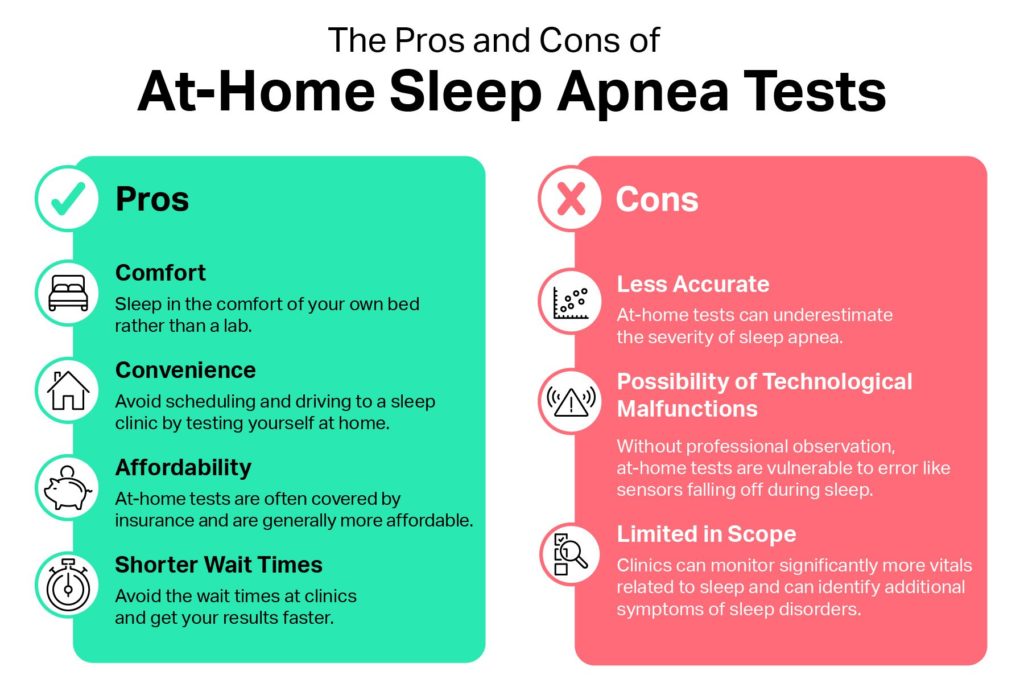
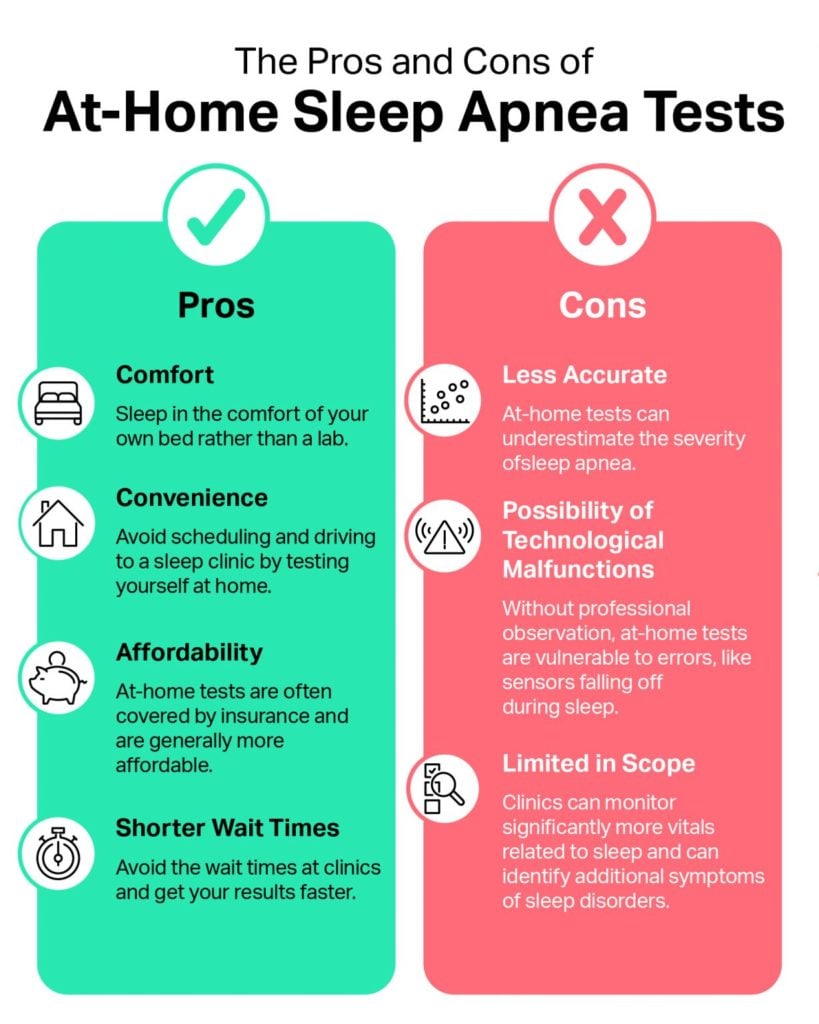
Benefits of At-Home Sleep Apnea Tests
The key benefits of an at-home sleep apnea test compared to traditional polysomnography are shorter wait times and increased convenience, affordability, and comfort.
Comfort
The alternative to an at-home sleep apnea test is an overnight sleep study conducted in a lab. Sleep centers aim to make these comfortable by providing a nice bedroom. However, you are still sleeping somewhere that feels unfamiliar, and there are technicians monitoring you while you sleep. A sleep apnea test at home may be preferable, as you can be in the comfort of your own home.
Convenience
At-home sleep apnea tests are generally more convenient than a polysomnogram. Instead of finding a sleep clinic, scheduling the overnight exam, and driving to and from the clinic, you can pick up the sleep apnea test at your local pharmacy or doctor’s office and administer the test yourself at home.
Affordability
At-home sleep apnea testing is generally more affordable than a polysomnogram and is often covered by insurance.
Shorter Wait Times
Whereas sleep clinics often have long waitlists, at-home sleep apnea tests can usually be administered more quickly as they do not require you to come into the lab. The sooner you receive a diagnosis of OSA, the sooner you can start treatment and begin to find relief from your symptoms.
Things to Consider About At-Home Sleep Apnea Tests
Taking a sleep apnea test at home offers many benefits, but there are some drawbacks to consider.
Less Accurate
When you take a sleep apnea test at home, the machine monitors your breathing once you turn it on. Instead of dividing the total number of respiratory events by your total sleep time, they are divided by the total amount of time you spend in bed, which tends to be longer. As a result, at-home tests can underestimate the severity of sleep apnea by calculating an hourly rate that appears lower than it really is. By contrast, polysomnography is able to record when you are sleeping and when you are awake for a more accurate score.
Possibility of Technological Malfunctions
Since they are not overseen by a qualified health professional, home sleep tests are more vulnerable to errors. For example, it is possible for sensors to fall off or become dislodged while you are sleeping, which you may not realize until you wake up. During a lab-based polysomnogram, on the other hand, a technician can reset the sensors and ensure everything is working as expected.

Limited in Scope
Home sleep apnea tests only monitor your breathing and oxygen levels. Overnight sleep studies monitor significantly more vitals related to sleep, including your brain waves and leg and eye movements. Because an at-home sleep apnea test does not capture information about total sleep time, nighttime awakenings, or sleep stages, it cannot test for non-breathing-related sleep disorders, such as narcolepsy.
At-home sleep tests are generally only used to diagnose obstructive sleep apnea. They are not currently indicated for central sleep apnea, a rarer form of sleep apnea where the pauses in breathing are caused not by a collapse of the airways, but by the brain’s failure to send signals to breathe.
If the results of your at-home sleep test are inconclusive, or if you have additional symptoms that warrant a more comprehensive evaluation, your doctor may recommend an additional polysomnogram. It is also important to note that while an at-home sleep test can be used to diagnose obstructive sleep apnea, an overnight study in a sleep lab allows for therapeutic intervention such as CPAP therapy.
How to Decide if an At-Home Sleep Apnea Test Is Right for You
At-home sleep apnea tests are currently prescribed to healthy adults with symptoms that suggest moderate or severe OSA, and not another sleep disorder. If that describes you, and you would prefer to take your test at home instead of in a sleep center, an at-home sleep apnea test may be the right choice for you.
If, on the other hand, you have an underlying health condition or sleep disorder, the increased accuracy and comprehensiveness offered by an overnight sleep study may be the better choice.
It is best to talk to your doctor about your options. They can help you make this decision based on your symptoms and personal medical history.

Still have questions? Ask our community!
Join our Sleep Care Community — a trusted hub of sleep health professionals, product specialists, and people just like you. Whether you need expert sleep advice for your insomnia or you’re searching for the perfect mattress, we’ve got you covered. Get personalized guidance from the experts who know sleep best.
References
6 Sources
-
Kim, R. D., Kapur, V. K., Redline-Bruch, J., Rueschman, M., Auckley, D. H., Benca, R. M., Foldvary-Schafer, N. R., Iber, C., Zee, P. C., Rosen, C. L., Redline, S., & Ramsey, S. D. (2015). An economic evaluation of home versus laboratory-based diagnosis of obstructive sleep apnea. Sleep, 38(7), 1027–1037.
https://pubmed.ncbi.nlm.nih.gov/26118558/ -
Collop, N. A. (2010). Home sleep testing: It is not about the test. Chest, 138(2), 245–246.
https://pubmed.ncbi.nlm.nih.gov/20682524/ -
Kundel, V., & Shah, N. (2017). Impact of portable sleep testing. Sleep Medicine Clinics, 12(1), 137–147.
https://pubmed.ncbi.nlm.nih.gov/28159092/ -
Punjabi, N. M., Patil, S., Crainiceanu, C., & Aurora, R. N. (2020). Variability and misclassification of sleep apnea severity based on multi-night testing. Chest, 158(1), 365–373.
https://pubmed.ncbi.nlm.nih.gov/32081650/ -
Lopes, T., Borba, M. E., Lopes, R., Fisberg, R. M., Lemos Paim, S., Vasconcelos Teodoro, V., Zalcman Zimberg, I., & Crispim, C. A. (2019). Eating late negatively affects sleep pattern and apnea severity in individuals with sleep apnea. Journal of Clinical Sleep Medicine, 15(3), 383–392.
https://pubmed.ncbi.nlm.nih.gov/30853037/ -
Alshaer, H., Ryan, C., Fernie, G. R., & Bradley, T. D. (2018). Reproducibility and predictors of the apnea hypopnea index across multiple nights. Sleep Science (Sao Paulo, Brazil), 11(1), 28–33.
https://pubmed.ncbi.nlm.nih.gov/29796198/


